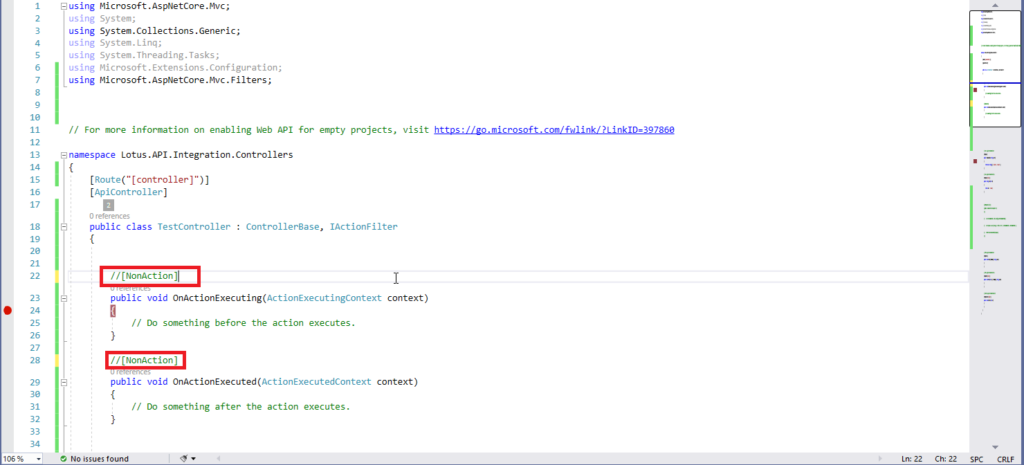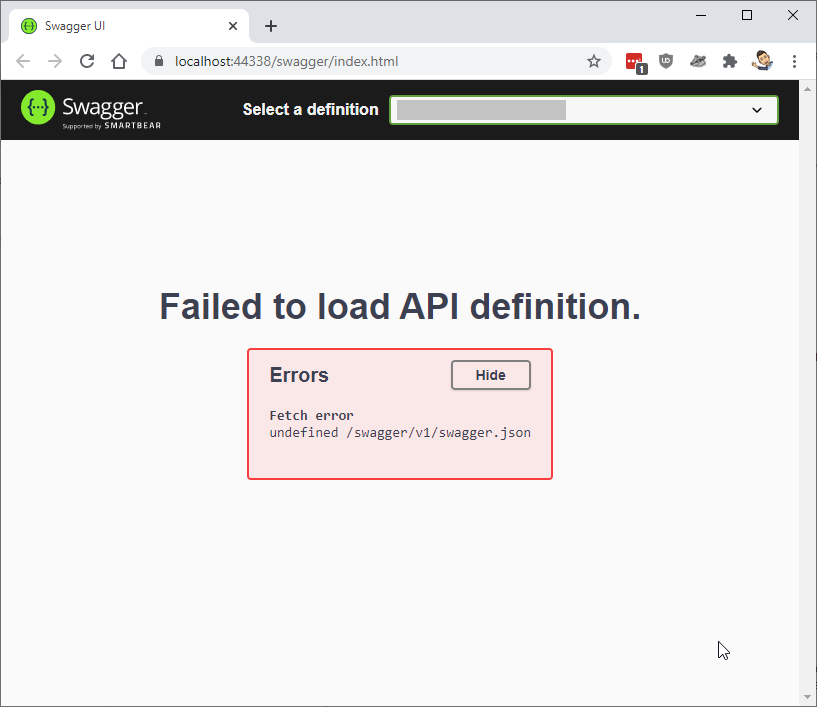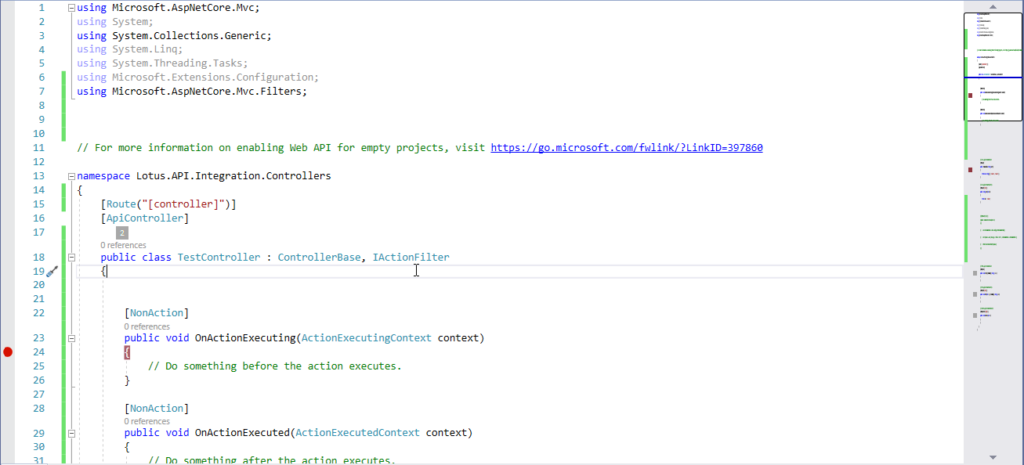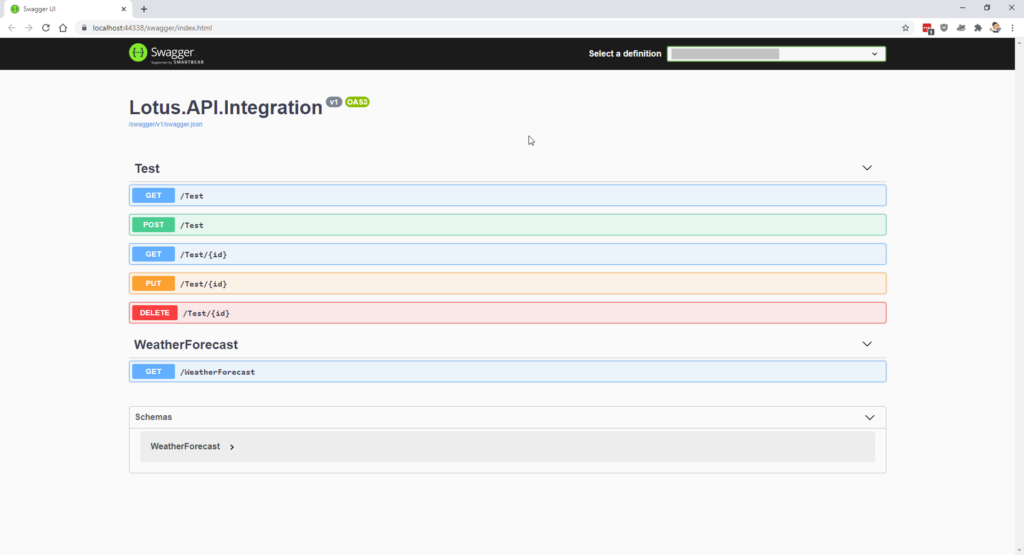Issue Description
Swagger Open API documentation gives the below error in .NET Core API etc.
“Failed to load API definition. Fetch error undefined /swagger/v1/swagger.json”
It is also observed that Swagger API documentation/description works on ‘localhost’ i.e locally but when it runs in publish mode i.e hosted on IIS or Cloud Server, produces the error like “Failed to load API definition” with undefined/swagger/v1/swagger.json error.
Resolution
Before applying this fix, I would recommend you to validate the swagger implementation with the below article,
- ASP.NET Core 3.1 or 5.0 – Add Swagger OpenAPI V3.0 specification documentation
- ASP.NET Core 2.2- Add Swagger v2.0 API documentation
Please make sure you verify the below points steps,
Resolution 1
Swagger Document is defined with proper Title and Version details, as both are required parameters.
Resolution 2
Please make sure the API doesn’t contain any conflicting action. Conflicting action could be using the same routes. To be on the safer side, you can very much use the below flag to control that behavior,
c.ResolveConflictingActions(x => x.First());
Resolution 3
Please make sure all controller methods are attributed with proper HTTP attributes Example- HttpGET or HttpPost etc. Missing this attribute could cause the error.
If the issue still persists then please apply the below fix to resolve the issue.
Resolution 5
Please check if the hosting server allows CORS request processing. Also, its important swagger UI-related resources like CSS or stylesheets are accessible from your server.
Resolution 6
Please, note that Swagger JSON will be exposed at the following route as per default behavior.
"/swagger/{documentName}/swagger.json".
If you are using a custom route or prefix, then the route MUST include the {documentName} parameter.
To fix the issue, please update the UseSwagger() as below,
app.UseSwagger(c =>
{
c.RouteTemplate = "<custom-name>/swagger/{documentName}/swagger.json";
});
Example,
c.RouteTemplate = "MyTestService/swagger/{documentName}/swagger.json";
The above changes also need to be reflected in SwaggerUI middleware. Please update the UseSwaggerUI method will be as follows,
app.UseSwaggerUI(c =>
{
c.SwaggerEndpoint("/<custom-name>/swagger/v1/swagger.json", "TestService");
});
Example:
app.UseSwaggerUI(c =>
{
c.SwaggerEndpoint("/MyTestService/swagger/v1/swagger.json", "TestService");
});
Please note that in Swaggerendpoint() method ‘documentName’ value is cases sensitive.
In fact, documentName is case sensitive anywhere else if referenced.
This documentName is generally a Group Name associated with API version
Example: It won’t work for V1 but works for v1.
If using RoutePrefix in API then it can be defined as below,
Example only if using RoutePrefix,
c.RoutePrefix= "MyTestService/swagger"
Here MyTestService is my service name.
Please see below the complete implementation,
Finally, Swagger runs successfully locally and in any hosting environment like IIS or Azure Cloud, etc.
For any other issues, please use google chrome dev tools(FUN F12) or Edge Developer tools to verify the exact error causing the issue. Please verify Console and Network tab to validate the exact erros.
Other References:
Add swagger to ASP.NET Core API in simple 2-3 steps:
- Swagger API Documentation in .NET Core 6 or 3.1
- Add Swagger API documentation to .NET Core 2.2
Did I miss anything else in these resolution steps?
Did the above steps resolve your issue? Please sound off your comments below!
Happy Coding !!
Please bookmark this page and share it with your friends. Please Subscribe to the blog to get a notification on freshly published best practices and guidelines for software design and development.
I created an ASP.NET Core 5 Web App for “API” (similar to MVC) with the OpenAPI (aka Swagger) option turned on.
To note: I have nearly 2 decades experience with .NET but this is my first real-world dive into .NET Core/5, so I’m skipping the whole “learning from first principals” and figuring it out as I go off the back of what I already know.
In this case I’m setting up a new project to move some part of an existing ASP.NET 4.6 MVC app into it.
It was all working fine until I wanted to add an OnActionExecuting() override to the Controller, from the IActionFilter interface.
Once I added the interface and the 2 required method the calls to the actual controller, calling the endpoints worked fine. But F5 debug runs of the project, which loaded the https://localhost:xxxxx/swagger/index.html page, would produce the error:
Failed to load API definition.
Errors
Fetch errorundefined /swagger/v1/swagger.json
Which in typical 3rd party framework fashion is fucking useless for consuming and gives use no useful information to work with.
So off to StackOverflow I go.
After a search for OnActionExecuting Fetch errorundefined /swagger/v1/swagger.json I came across this page: https://stackoverflow.com/questions/48450262/asp-net-core-swashbuckle-not-creating-swagger-json-file, specifically the answer https://stackoverflow.com/a/53632914/115704 which mentioned [NoAction]. Things then clicked for me.
The [NoAction] attribute on the 2 interface methods didn’t work for me, but after a bit more searching I found [NonAction] and which solved the problem.
Then I was back up and working with Swagger again.
Screenshots
Code before the fix
(Noting the [NonAction] is not impmented)
The error from Swagger
Honestly, how fucking useless is this an an error? About as good as the classic “an unexpected error occurred” (to which I always exclaim: “no shit, Sherlock!” Like any developer actually expects an error).
Code after the Fix
[NonAction] attributes have been implemented.
Swagger after the fix
And look, Swagger works again.
At the end of the day this was a couple of hours of my night lost.
Partly my fault for implementing a new version of .NET without doing the obligatory 40 hours of training. Also partly Swaggers fault because, well, it pissed me off for not giving a more detailed error message, especially in a development environment.
I was working with some ASP.NET WebApi code and needed to test something using the Swagger UI. Usually, it’s just a matter of starting the project and going to your /swagger directory. Unfortunately, in this case, I went to my swagger URL and got an error saying “Failed to load API definition — Fetch error — Internal Server Error /swagger/v1/swagger.json.” How do you fix this error?
I knew that it used to work but I’d just updated about a half zillion things in my code including upgrading to .NET Core 5 so I wasn’t really sure what broke it. I assumed the worst.
The dev tools in Edge was showing me that it was trying to access swagger.json but it was getting an HTTP 500 error. My guess was that I had a configuration problem in Startup.cs and that the swagger.json file either wasn’t being generated or it was in the wrong place. I checked a bunch of stuff and didn’t find anything.
I eventually started to figure out what was going wrong when I opened that call to swagger.json in its own tab.
The actual error message says that there’s an “ambiguous HTTP method for action”. I wasn’t really sure what that meant by helpfully the error message pointed me at the WebApi endpoint action that was causing the problem. Rather than being a problem with some kind of swagger config, the error was coming from the code that I’d just been working on.
Swashbuckle.AspNetCore.SwaggerGen.SwaggerGeneratorException: Ambiguous HTTP method for action - SwaggerError.WebApi.Controllers.WeatherForecastController.Overview (SwaggerError.WebApi). Actions require an explicit HttpMethod binding for Swagger/OpenAPI 3.0
at Swashbuckle.AspNetCore.SwaggerGen.SwaggerGenerator.GenerateOperations(IEnumerable`1 apiDescriptions, SchemaRepository schemaRepository)
at Swashbuckle.AspNetCore.SwaggerGen.SwaggerGenerator.GeneratePaths(IEnumerable`1 apiDescriptions, SchemaRepository schemaRepository)
at Swashbuckle.AspNetCore.SwaggerGen.SwaggerGenerator.GetSwagger(String documentName, String host, String basePath)
at Swashbuckle.AspNetCore.Swagger.SwaggerMiddleware.Invoke(HttpContext httpContext, ISwaggerProvider swaggerProvider)
at Microsoft.AspNetCore.Diagnostics.DeveloperExceptionPageMiddleware.Invoke(HttpContext context)Here’s the code that’s causing the problem:
[ApiController]
[Route("[controller]")]
public class WeatherForecastController : ControllerBase
{
[Route("/[controller]/[action]/{id}")]
public ActionResult Overview(int? id)
{
return Ok(id);
}
}Looks pretty ordinary, right? Nothing to exciting here. So what’s broken? What’s “ambiguous” about this? It’s missing the HttpGet attribute.
[ApiController]
[Route("[controller]")]
public class WeatherForecastController : ControllerBase
{
[HttpGet]
[Route("/[controller]/[action]/{id}")]
public ActionResult Overview(int? id)
{
return Ok(id);
}
}As soon as I added that missing [HttpGet] attribute, the Swagger UI was working again.
Summary
In short, the problem was a problem in my code. I’d assumed that my WebApi controller action would default to HTTP GET but it seems that that doesn’t agree with Swagger. As soon as I added that missing attribute, everything was fine.
I hope this helps.
-Ben
— Looking for help on your .NET Core projects? Want some guidance on how to get going with Azure DevOps or GitHub Actions? Need a Scrum coach to help your teams get over a delivery slump? We can help. Drop us a line at info@benday.com.
Simply navigate to https://localhost:{PortNo}/swagger/v1/swagger.json and get much more details about the error message.
I was able to find the error by opening the network tab and looking at the response for swagger.json
I’ve been working with .Net Core 3.1 and I spent some time to find out and understanding what was going on.
The issue can arise from many different reasons:
-
Swagger configuration errors
-
Classes with the same name but in different namespaces
-
Public methods without the rest attribute (Get, Post, etc.)
First, take a look the link below just to check if your setup is ok:
Add Swagger(OpenAPI) API Documentation in ASP.NET Core 3.1
Then,
A good tip to find out the problem is to run the application without to use IISExpress and check the console log. Any error found to generate the documentation will be displayed there.
In my case, the problems was that I had a public method (that should be private) without any rest attribute:
After change the method from public to private I solve the issue.
So after a lot of troubleshooting it came down to basically two things, but I feel that in general this could be helpful to someone else in the future so I’m posting an answer.
First- if ever your stuck with the aforementioned error the best way to actually see whats going on is by adding the following line to your Configure() method
app.UseDeveloperExceptionPage();
Now if you navigate to the ‘swagger/v1/swagger.json’ page you should see some more information which will point you in useful direction.
Second- now for me the error was something along the lines of
‘Multiple operations with path ‘some_path’ and method ‘GET’ ‘
However these API were located inside of dependency libraries so I was unable to apply a solution at the point of definition. As a workaround I found that adding the following line to your ConfigureServices() method resolved the issue
services.AddSwaggerGen(c =>
{
c.SwaggerDoc("v1", new Info { Title = "API WSVAP (WebSmartView)", Version = "v1" });
c.ResolveConflictingActions(apiDescriptions => apiDescriptions.First()); //This line
});
Finally- After all that I was able to generate a JSON file but still I wasn’t able to pull up the UI. In order to get this working I had to alter the end point in Configure()
app.UseSwaggerUI(c =>
{
c.SwaggerEndpoint("./v1/swagger.json", "My API V1"); //originally "./swagger/v1/swagger.json"
});
I’m not sure why this was necessary, although it may be worth noting the web application’s virtual directory is hosted on IIS which might be having an effect.
NOTE: Navigating to swagger/v1/swagger.json will give you more details, for me it was causing issue due to undecorated action. This information is mentioned in comment by @MarkD
Hope this helps someone in the future.
I’m having troubles with swagger ui after publishing Web.Host-project to on-premise IIS. It’s just a test-deployment and is therefor located in a subfolder (accessible via <a class=»postlink» href=»https://mydomain.local/project-name/»>https://mydomain.local/project-name/</a>).
swagger ui shows following error message:
Failed to load API definition.
Errors
Fetch error
Not Found /swagger/v1/swagger.json
I guess this is because the project is located in a subfolder!?
If so, please, tell me how to make this work!
8 Answer(s)
-
I assumed that your subfolder refer to sub-site.
If so, it is resolved by <a class=»postlink» href=»https://github.com/aspnetzero/aspnet-zero-core/issues/1476″>https://github.com/aspnetzero/aspnet-ze … ssues/1476</a>.
-
Thank you for your reply!
Your information did help me solve the problem after all!
Although it was not the only bit that had to be edited to make it all work. There also is the file Web.Hostwwwrootswaggeruiindex.html that has to be edited — it references two files using absolute paths:
<script src="/project-name/swagger/ui/abp.js"></script> <script src="/project-name/swagger/ui/abp.swagger.js"></script>Maybe, this information should/could be included to the ticket you linked!?
Anyway, thank you very much for your help!
-
already fixed.
<a class=»postlink» href=»https://github.com/aspnetzero/aspnet-zero-core/commit/b20c367744296a10b89c4c255094b600c8bdded5#diff-d6079b3a17e1fb63a7b9442a0bf90a81″>https://github.com/aspnetzero/aspnet-ze … 2a0bf90a81</a>
-
Great
that’s way better!
-
I was happy too soon — the API itself is still not working … there must be even more places left to be edited.
-
Does swagger API UI load correctly for you now?
What are the errors for the APIs?
-
Yes, swagger ui looks good so far!
But authorization doesn’t work. At first, I thought it wasn’t a big problem — the URI was lacking the ‘project-name’, so I edited Web.Hostwwwrootswaggeruiabp.swagger.js. But there is still something else going wrong as I now receive HTTP 500 when trying to authenticate.
-
Okay, there was an issue with the connection to the DB — it’s working now
ASP.NET Core–Swagger error when using a virtual directory
After changing our ASP.NET Core application to no longer run under the root site(e.g. https://localhost/) but under a virtual directory instead (e.g. https://localhost/mysampleapp/) , loading the API definitions in Swagger no longer worked and failed with the following error message:
Fetch error undefined swagger/v1/swagger.json
To fix the problem, I had to do 2 things:
First I updated the Swagger json generation to set the SwaggerDoc to a specific path. Although the documentation mentions the first parameter of SwaggerDoc as the name, it becomes part of the URI of your swagger.json file.
In this case I set the name to ‘v1’:
As a second step, I had to update the Swagger UI configuration to generate the swagger endpoint on a relative path. Important here is that the name of the swagger doc matches part of the URI before the swagger.json; in our case ../swagger/v1/swagger.json
Popular posts from this blog
A colleague asked me to take a look at the following code inside a test project: My first guess would be that this code checks that the specified condition(the contains) is true for every element in the list. This turns out not to be the case. The Assert.Collection expects a list of element inspectors, one for every item in the list. The first inspector is used to check the first item, the second inspector the second item and so on. The number of inspectors should match the number of elements in the list. An example: The behavior I expected could be achieved using the Assert.All method:
I’m really bad at remembering emoji’s. So here is cheat sheet with all emoji’s that can be used in tools that support the github emoji markdown markup: All credits go to rcaviers who created this list.
As long you are running your Angular application at a root URL (e.g. www.myangularapp.com ) you don’t need to worry that much about either the ‘—deploy-url’ and ‘—base-href’ parameters. But once you want to serve your Angular application from a server sub folder(e.g. www.mywebsite.com/angularapp ) these parameters become important. —base-href If you deploy your Angular app to a subfolder, the ‘—base-href’ is important to generate the correct routes. This parameter will update the <base href> tag inside the index.html. For example, if the index.html is on the server at /angularapp/index.html , the base href should be set to <base href=»/angularapp/»> . More information: https://angular.io/guide/deployment —deploy-url A second parameter that is important is ‘—deploy-url’. This parameter will update the generated url’s for our assets(scripts, css) inside the index.html. To make your assets available at /angularapp/, the deploy url should














 that’s way better!
that’s way better!